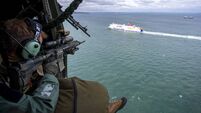Tsunamis: the deadliest waves in modern history
More than 36,000 people were killed by tsunamis following the explosion of the volcano Krakatau in the Sunda Strait near Indonesia’s Java island on August 27, 1883. Many estimates of the number killed in that disaster were even higher.
The death toll from Sunday’s tsunamis looks set to top 100,000 in 12 nations.
Following the 1883 eruption, 90-foot high waves slammed ashore on nearby islands, wiping out coastal communities in what is now Indonesia. They had been the deadliest tsunamis of modern times until now. The earliest description of a tsunami-type wave comes from 479 BC in the northern part of the Aegean Sea. Similar waves have been reported worldwide, though they are more common in the Pacific, with its earthquake-prone perimeter.
Many historians believe the explosive eruption of Santorini in the Aegean Sea in 1500 BC caused a tsunami that brought widespread devastation to the eastern Mediterranean and Crete.
Thousands of coastal residents in Spain, Portugal and North Africa were killed by waves spawned by an earthquake at Lisbon, Portugal, in 1755.
Over the centuries, Japan has been the land most plagued by tsunamis, with at least 66,000 deaths recorded there since 684 AD. Among the deadliest tsunamis was one that struck Honshu in 1896, killing 27,000.














